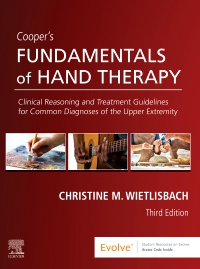
Cooper's Fundamentals of Hand Therapy, 3rd Edition
Hardcover

Written for hand therapy specialists and non-specialists, Cooper's Fundamentals of Hand Therapy, 3rd Edition emphasizes treatment fundamentals, and provides tips and guidelines for hand therapy practice. This easy-to-use illustrated text and reference guide helps students further develop their clinical reasoning skills by describing what goes into the evaluation process, highlighting the humanistic side of each encounter through case studies, and providing the wisdom the contributing authors have acquired through years of practice. This new edition also features additional chapters on the use of common physical agents and orthoses, plus added content on how to integrate evidence-based findings into daily hand practice.
-
- NEW! Chapter covering Physical Agent Modalities helps students understand how to use common hand therapy tools
- NEW! Evidence-Based Practice content outlines how to closely examine evidence and integrate it into daily hand therapy practice
- UPDATED! Chapter covering Orthoses Essential Concepts reflects the latest information in the field
- NEW! Photos and illustrations throughout provide clear examples of tools, techniques, and therapies
- Case studies with questions and resolutions help students develop strong clinical reasoning skills while presenting the human side of each client encounter
- Special features sections such as Questions to Discuss with the Physician, What to Say to Clients, Tips from the Field, and more help students find their own clinical voices
- Anatomy sections throughout text highlight important anatomical bases of dysfunctions, injuries, or disorders
- Clinical Pearls highlight relevant information from an experienced author and contributors that students can apply to clinical practice in the future
- Evaluation Techniques and Tips help students master appropriate and thorough clinical evaluation of clients
- Diagnosis-specific information in the final section of the book is well-organized to give students quick access to the information they need
-
- NEW! Chapter covering Physical Agent Modalities helps you understand how to use common hand therapy tools
- NEW! Evidence-Based Practice content outlines how to closely examine evidence and integrate it into daily hand therapy practice
- NEW! Photos and illustrations throughout provide clear examples of tools, techniques, and therapies
-
Part One: Fundamentals
1. Fundamentals: Hand Therapy Concepts and Treatment Techniques
2. Evidence-Based Practice: The Basic Tools
3. Functional Anatomy
4. Evaluation of the Hand and Upper Extremity
5. Assessment of Functional Outcomes
6. Hand Coordination
7. Orthoses: Essential Concepts
8. Fundamentals of Edema Management
9. Physical Agent Modalities in the Hand Clinic
10. Tissue-Specific Exercises for the Upper Extremity
11. Clinical Reasoning and Problem-Solving in Upper Extremity Rehabilitation
12. Fundamentals of Client-Therapist Rapport
13. Facilitating Adherence to the Plan of Care
14. Narratives in Hand Therapy
15. Utilization of Therapy Assistants in Hand Therapy
16. Some Thoughts on Professionalism
Part Two: Clinical Reasoning and Treatment Guidelines for Common Diagnoses of the Upper Extremity
17. Wounds
18. Common Shoulder Diagnoses
19. Elbow Diagnoses
20. Peripheral Nerve Problems
21. Wrist Fractures
22. Wrist Instabilities
23. Hand Fractures
24. Elbow, Wrist, and Hand Tendinopathies
25. Finger Sprains and Deformities
26. Flexor Tendon Injury
27. Extensor Tendon Injury
28. Tendon and Nerve Transfers
29. Arthritis
30. Burns
31. Infections
32. Dupuytren Contracture
33. Ganglions and Tumors of the Hand and Wrist
34. Traumatic Hand Injury Involving Multiple Structures
35. The Stiff Hand
36. The Neurologic Hand
37. Complex Regional Pain Syndrome and Pain
38. Chemotherapy-Induced Peripheral Neuropathy
39. Functional Somatic Syndromes or Challenging Behavior



 as described in our
as described in our 